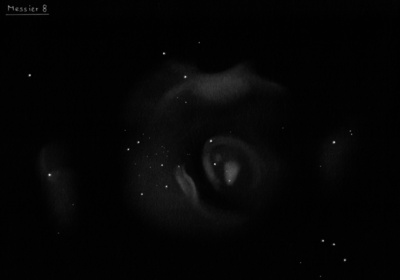Lagoon Nebula
Lagoon Nebula

Giovanni Hodierna discovered NGC 6530, the associated cluster within M8 = Lac III-13 = h3722. He catalogued it as II. 6 in his 1654 "De Admirandis Coeli Caracteribus". John Flamsteed called it a "nebula" around 1680 but Guillaume Le Gentil was perhaps the first to recognize (telescopically) the mix of nebulosity and stars around 1747. Using a small 18- to 20-foot focal length refractor, he noted "a small nebulosity like the tail of a comet with numerous stars." His position was off, though, by more the one degree.
Earlier observers appear to have thought the naked-eye glow resolved into stars in a telescope. When Philippe de Cheseaux reviewed Flamsteed's observation in 1745-46 he concluded the object appeared as a "truly nebulous" star naked-eye but as a star cluster through a telescope. Nicolas-Louis de Lacaille catalogued M8 as a nebulous star (III. 13), based on his observation at the Cape in 1751-52, though with a 1/2-inch telescope he couldn't resolve the object. Messier's 1764 observation mentioned "a cluster of stars that appears to be a nebula when observed with a simple three-foot refractor; with an excellent instrument, however, one sees only a large number of faint stars. Near this cluster there is a fairly bright star [9 Sgr], which is surrounded by a very faint glow."
William Herschel observed M8 on 22 May 1784 (sweep 223) and logged "large, extended, pretty bright, broad. The nebulosity of the milky kind, there are some pB stars in it, but they seem to have no connection with it, being of very different sizes [magnitudes] and colours and resembling the other stars that are everywhere scattered about in this neighborhood. This is probably the star surrounded with nebulosity mentioned by Messier. There is indeed one of the stars which are in the nebula that is somewhat larger [brighter] than the rest and may be the only one he saw." John Herschel produced a beautiful drawing of the nebula with carefully positioned stars (Plate I, fig 1), though Wilhelm Tempel questioned it as differing significantly from his own.
Stephen O'Meara states, "The word "Lagoon" was probably first used in association with M8 by Agnes M. Clerke in her 1890 wor entitled The System of the Stars."
400/500mm - 17.5" (6/6/86): extremely bright, detailed nebulosity that nearly fills a 50' field. Extensive fainter nebulosity fills the region to the north and a thin extension is to the east. Cut by a large high contrast dark lane ("Lagoon") oriented SW-NE. The brightest luminary within the nebula is 9 Sagittarii (V = 6.0), situated to the west of the dark lane with a mag 7 companion 3' NNE. A very bright 30" nebulous knot ("Hourglass Nebula", ionized by O7 star Herschel 36) is situated 3' SW of 9 Sagittarii. NGC 6530, a bright open cluster, is on the east side of the dark lane. Barnard 89 is a fairly well-defined roundish dark nebula ~6' following NGC 6530. The Lagoon is a prominent naked-eye object in dark sky. See observing notes for NGC 6530 and IC 1271. The Trifid Nebula (M20) lies 85' NNW.
Notes by Steve Gottlieb